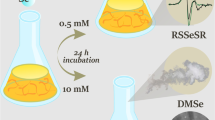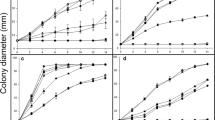Abstract
We report for the first time that the medicinal basidiomycete Lentinula edodes can reduce selenium from inorganic sodium selenite (SeIV) and the organoselenium compound 1,5-diphenyl-3-selenopentanedione-1,5 (DAPS-25) to the elemental state, forming spherical nanoparticles. Submerged cultivation of the fungus with sodium selenite or with DAPS-25 produced an intense red coloration of L. edodes mycelial hyphae, indicating accumulation of elemental selenium (Se0) in a red modification. Several methods, including transmission electron microscopy (TEM), electron energy loss spectroscopy (EELS), and X-ray fluorescence, were used to show that red Se0 accumulated intracellularly in the fungal hyphae as electron-dense nanoparticles with a diameter of 180.51±16.82 nm. Under designated cultivation conditions, shiitake did not reduce selenium from sodium selenate (SeVI).
Similar content being viewed by others
References
Ball, D.W. 2006. Concentration scales for sugar solutions. J. Chem. Educ. 83, 1489–1491.
Brady, J.M., Tobin, J.M., and Gadd, G.M. 1996. Volatilization of selenite in aqueous medium by a Penicillium species. Res. Microbiol. 100, 955–961.
Díaz Huerta, V., Fernández Sánchez, M.L., and Sanz-Medel, A. 2006. An attempt to differentiate HPLC-ICP-MS selenium speciation in natural and selenised Agaricus mushrooms using different species extraction procedures. Anal. Bioanal. Chem. 384, 902–907.
Durán, N., Marcato, P.D., De Souza, G.I.H., Alves, O.L., and Esposito, E. 2007. Antibacterial effect of silver nanoparticles produced by fungal process on textile fabrics and their effluent treatment. J. Biomed. Nanotechnol. 3, 203–208.
Eszenyi, P., Sztrik, A., Babka, B., and Prokisch, J. 2011. Production of Lactomicrosel® and nanosize (100–500 nm) selenium spheres by probiotic lactic acid bacteria. Int. Conf. Food Eng. Biotechnol. 9, 97–101.
Falandysz, J. 2008. Selenium in edible mushrooms. J. Environ. Sci. Health C Rev. Environ. Carcinog. Ecotoxicol. Rev. 26, 256–299.
Fernández-Martínez, A. and Charlet, L. 2009. Selenium environmental cycling and bioavailability: a structural chemist point of view. Rev. Environ. Sci. Biotechnol. 8, 81–110.
Fesharaki, P.J., Nazari, P., Shakibaie, M., Rezaie, S., Banoee, M., Abdollahi, M., and Shahverdi, A.R. 2010. Biosynthesis of selenium nanoparticles using Klebsiella pneumoniae and their recovery by a simple sterilization process. Brazil J. Microbiol. 41, 461–466.
Gao, X., Zhang, J., and Zhang, L. 2002. Hollow sphere selenium nanoparticles: their in vitro anti hydroxyl radical effect. Adv. Mater. 14, 290–293.
Garbisu, C., Ishii, T., Leighton, T., and Buchanan, B.B. 1996. Bacterial reduction of selenite to elemental selenium. Chem. Geol. 132, 199–204.
Gharieb, M.M., Wilkinson, S.C., and Gadd, G.M. 1995. Reduction of selenium oxyanions by unicellular, polymorphic and filamentous fungi: cellular location of reduced selenium and implications for tolerance. J. Indust. Microbiol. 14, 300–311.
Hunter, W.J. and Kuykendall, L.D. 2007. Reduction of selenite to elemental red selenium by Rhizobium sp. strain B1. Curr. Microbiol. 55, 344–349.
Hunter, W.J. and Manter, D.K. 2009. Reduction of selenite to elemental red selenium by Pseudomonas sp. strain CA5. Curr. Microbiol. 58, 493–498.
Krumov, N., Perner-Nochta, I., Oder, S., Gotcheva, V., Angelov, A., and Posten, C. 2009. Production of inorganic nanoparticles by microorganisms. Chem. Eng. Technol. 32, 1026–1035.
Munoz, A.H.S., Kubachka, K., Wrobel, K., Corona, J.F.G., Yathavakilla, S.K.V., Caruso, J.A., and Wrobel, K. 2006. Se-enriched mycelia of Pleurotus ostreatus: distribution of selenium in cell walls and cell membranes/cytosol. J. Agric. Food Chem. 54, 3440–3444.
Musarrat, J., Dwivedi, S., Singh, B.R., Saquib, Q., and Al-Khedhairy, A.A. 2011. Microbially synthesized nanoparticles: scope and applications, pp. 101–126. In Ahmad, I., Ahmad, F., and Pichtel, J. (eds.), Microbes and microbial technology: agricultural and environmental applications. Springer, New York, USA.
Narayanan, K.B. and Sakthivel, N. 2010. Biological synthesis of metal nanoparticles by microbes. Adv. Coll. Interf. Sci. 156, 1–13.
Ogra, Y., Ishiwata, K., Encinar, J.R., Lobinski, R., and Suzuki, K.T. 2004. Speciation of selenium in selenium-enriched shiitake mushroom Lentinula edodes. Anal. Bioanal. Chem. 379, 861–866.
Oremland, R.S., Herbel, M.J., Switzer Blum, J., Langley, S., Beveridge, T.J., Ajayan, P.M., Sutto, T., Ellis, A.V., and Curran, S. 2004. Structural and spectral features of selenium nanospheres produced by Se-respiring bacteria. Appl. Environ. Microbiol. 70, 52–60.
Pearce, C.I., Coker, V.S., Charnock, J.M., Pattrick, R.A.D., Mosselmans, J.F.W., Law, N., Beveridge, T.J., and Lloyd, J.R. 2008. Microbial manufacture of chalcogenide-based nanoparticles via the reduction of selenite using Veillonella atypica: an in situ EXAFS study. Nanotechnology 19, 1–13.
Peng, D., Zhang, J., Liu, Q., and Taylor, E.W. 2007. Size e ect of elemental selenium nanoparticles (Nano-Se) supranutritional levels on selenium accumulation and glutathione S-transferase activity. J. Inorg. Biochem. 101, 1457–1463.
Philip, D. 2009. Biosynthesis of Au, Ag and Au-Ag nanoparticles using edible mushroom extract. Spectrochim. Acta A: Mol. Biomol. Spectrosc. 73, 374–381.
Poluboyarinov, P.A., Vikhreva, V.A., Leshchenko, P.P., Aripovskii, A.V., and Likhachev, A.N. 2009. Elemental selenium formation upon destruction of the organoselenium compound DAFS-25 molecule by growing fungal mycelium. Moscow Univ. Biol. Sci. Bull. 64, 164–168.
Popescu, M., Velea, A., and Lőrinczi, A. 2010. A biogenic production of nanoparticles. Digest J. Nanomater. Biostruct. 5, 1035–1040.
Prakash, N.T., Sharma, N., Prakash, R., Raina, K.K., Fellowes, J., Pearce, C.I., Lloyd, J.R., and Pattrick, R.A.D. 2009. Aerobic microbial manufacture of nanoscale selenium: exploiting nature’s bio-nanomineralization potential. Biotechnol. Lett. 31, 1857–1862.
Prokisch, J. and Zommara, M.A. 2010. Process for producing elemental selenium nanospheres. Patent application publication, No US 2010/0189634 A1.
Rai, M. and Duran, N. 2011. Metal nanoparticles in microbiology. Springer, Berlin, Germany.
Ramadan, H.E., Razak, A.A., Yousseff, Y.A., and Sedky, N.M. 1988. Selenium metabolism in a strain of Fusarium. Biol. Trace Element Res. 18, 161–170.
Rayman, M.P., Infante, H.G., and Sargent, M. 2008. Food-chain selenium and human health: spotlight on speciation. Br. J. Nutr. 100, 238–253.
Reilly, C. 2006. Selenium in food and health. Springer, New York.
Reynolds, E.S. 1963. The use of lead citrate at high pH as an electron opaque stain in electron microscopy. J. Cell Biol. 17, 208–212.
Roux, M., Sarret, G., Pignot-Paintrand, I., Fontecave, M., and Coves, J. 2001. Mobilization of selenite by Ralstonia metallidurans CH34. Appl. Environ. Microbiol. 67, 769–773.
Sastry, M., Ahmad, A., Khan, M.I., and Kumar, R. 2003. Biosynthesis of metal nanoparticles using fungi and actinomycete. Curr. Sci. 85, 162–170.
Tandler, B. 1990. Improved uranyl acetate staining for electron microscopy. J. Electron Microsc. Tech. 16, 1505–1517.
Turło, J., Gutkowska, B., and Herold, F. 2010. Effect of selenium enrichment on antioxidant activities and chemical composition of Lentinula edodes (Berk.) Pegl. mycelial extracts. Food Chem. Toxicol. 48, 1085–1091.
Turło, J., Gutkowska, B., and Malinowska, E. 2007. Relationship between the selenium, selenomethionine, and selenocysteine content of submerged cultivated mycelium of Lentinula edodes (Berk.). Acta Chromatogr. 18, 36–48.
Turner, R.J., Weiner, J.H., and Taylor, D.E. 1998. Selenium metabolism in Escherichia coli. BioMetals 11, 223–227.
Wang, Y. 2009. Differential effects of sodium selenite and nano-Se on growth performance, tissue Se distribution, and glutathione peroxidase activity of avian broiler. Biol. Trace Element Res. 128, 184–190.
Wang, H., Zhang, J., and Yu, H. 2007. Elemental selenium at nano size possesses lower toxicity without compromising the fundamental effect on selenoenzymes: Comparison with selenomethionine in mice. Free Radical Biol. Med. 42, 1524–1533.
Zhang, J., Wang, X., and Xu, T. 2008. Elemental selenium at nano size (nano-Se) as a potential chemopreventive agent with reduced risk of selenium toxicity: comparison with Se-methylselenocysteine in mice. Toxicol. Sci. 101, 22–31.
Zhao, L., Zhao, G., Zhao, Z., Chen, P., Tong, J., and Hu, X. 2004. Selenium distribution in a Se-enriched mushroom species of the genus Ganoderma. J. Agric. Food Chem. 52, 3954–3959.
Author information
Authors and Affiliations
Corresponding author
Rights and permissions
About this article
Cite this article
Vetchinkina, E., Loshchinina, E., Kursky, V. et al. Reduction of organic and inorganic selenium compounds by the edible medicinal basidiomycete Lentinula edodes and the accumulation of elemental selenium nanoparticles in its mycelium. J Microbiol. 51, 829–835 (2013). https://doi.org/10.1007/s12275-013-2689-5
Received:
Accepted:
Published:
Issue Date:
DOI: https://doi.org/10.1007/s12275-013-2689-5




